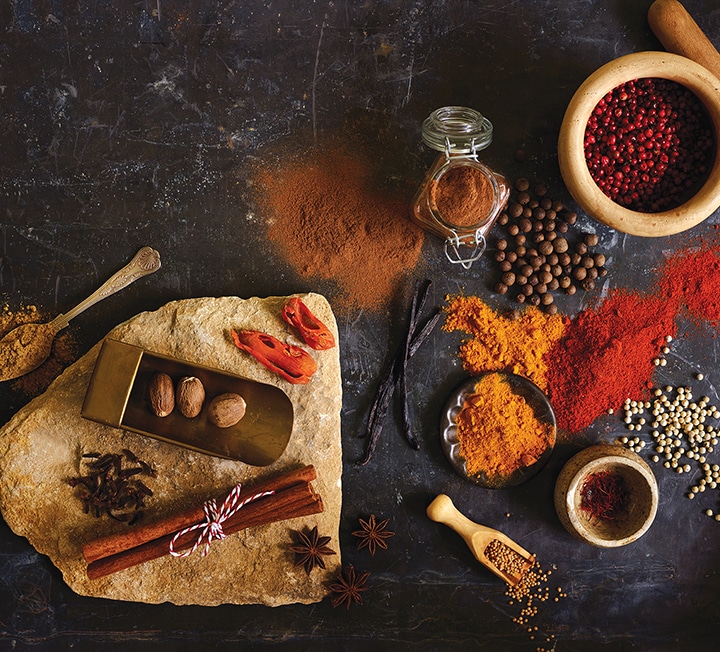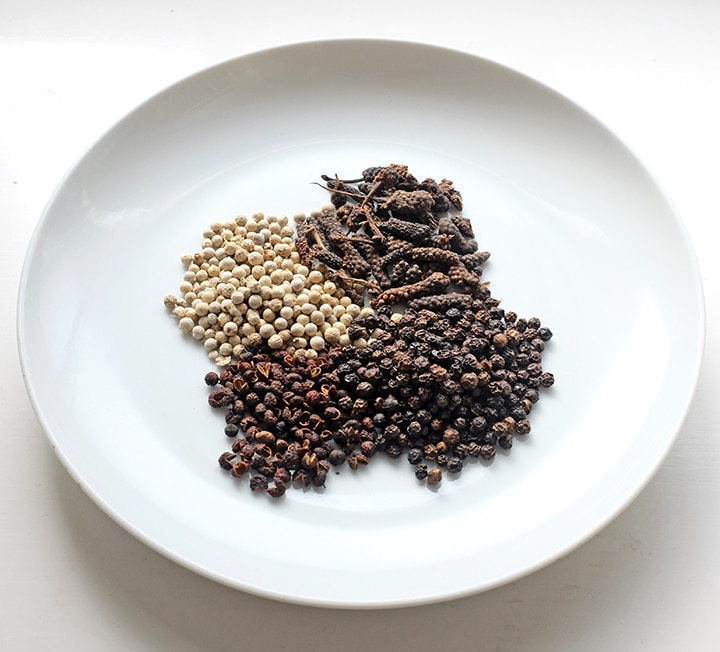The spice series: turmeric, galangal & ginger
Ed Smith takes an in-depth look at the many spices available at the Market. This month: turmeric, galangal & ginger


“TURMERIC IS A SPICE THAT HAS BEEN UTILISED BY BRITISH COOKS FOR CENTURIES, MOST NOTABLY IN PRESERVES ALONGSIDE MUSTARD”
Image: Ed Smith
These three spices – a triptych of related roots – evoke memories of food from south-east Asia and the Indian sub-continent. Which should be no surprise, as they’re native to those lands. Yet ginger (in particular), turmeric (in part), and galangal (just a bit) get used in western cooking, too, which reflects the fact that they have been traded for as long as any other spice – galangal even gets a mention by Chaucer.
When researching this piece, it became clear that many of the ‘authentic’ eastern recipes that use these three spices use them in their raw or ‘fresh’ form. However, for the purposes of this column, we’re more interested in what happens when we use them once dried. In fact, the recipes and techniques that involve dried and ground turmeric, ginger and galangal are actually more likely to be well-established western ones; conceivably because once the spice had travelled across oceans, the roots were no longer ‘fresh’, and were actually best if already boiled, baked, dried and later on ground.
As always, ground spices keep for six to 12 months in an airtight container before they start to lose potency (of flavour, if not colour).
Turmeric
Due to its yellow colour and belligerent staining ability, turmeric is sometimes known as ‘Indian saffron’ or ‘false saffron’. Yet it has nothing to do with the stamens of the crocus flower. In fact, the ground turmeric powder you have at the back of your spice cupboard derives from a root in the ginger family, mostly grown in south Asia.
As with ginger, it is possible to find turmeric roots in fresh form. Masses of turmeric roots (rhizomes) are harvested around 10 months after being planted. The finger-sized stubs that are collected are boiled then baked until dry, and (generally) ground into the powder you’re familiar with.
The taste is a fairly bitter, near acrid one, though it is also quite mild and tends to be used alongside other spices to add a layer of flavour to a savoury dish, rather than act as the star as things like cumin, fennel seed and black peppercorns might.
Turmeric can be purchased in dried root form – Spice Mountain advises grating it like nutmeg. If you plan to use a fair quantity of it, it’s best to buy when already a powder.
Ginger
Like turmeric, ginger is a flowering plant whose pungent roots (rhizomes) are harvested and used the world over to flavour foods. The plant is thought to originate from the Indian sub-continent, but it’s been farmed across the world for centuries and is vital to multiple cuisines. It is, of course, often used fresh, where its piquant, fiery, near sour-citrus yet soothing flavour is unmistakable.
Young ‘stem’ ginger, candied before it becomes fibrous, is popular too. Dried ginger is processed in the same way as turmeric, and is particularly well used in spice mixes, curry powders and in baking. It’s possible that its tongue-tickling heat is intensified when dried and ground, and it certainly provides a warming background whenever it’s used.
Again, ginger can be purchased in dried root form – again, Spice Mountain advises grating it, but you will find it more practical in pre-ground form.
Galangal
Galangal is also a plant in the ginger family, and the flavoursome part, again, come from the mass of rhizomes that grow under the ground. It is paler and woodier than the ginger root you’re well accustomed to (almost ivory-like), and again is boiled and then baked before being ground (if not used in raw form).
Technically there are two main types of galangal: ‘greater’ galangal from Indonesia and Laos, and ‘lesser’ from south China. The Laos variety is most common over here and, indeed, its peppery, citrusy, piney flavour is something we associate with south-east Asian cooking: Thai, Indonesian, Vietnamese and, of course, Laotian.
Most Western interpretations of recipes incorporating galangal suggest it in raw form. To be honest it is best like this, though you could use dried roots or ground galangal as a substitute which, unless your home cooking is regularly pointed at south Asian cookbooks, also means you can have the flavour in your cupboard for the rare occasions you require it. It’s a tricky one to grate or grind, so you may want to buy it pre-ground. It’s often a flavouring for coconut-based soups and stews – you could try to add the dried root and hope the liquid helps to reconstitute it, releasing the flavours while that happens.
Culinary uses
Turmeric is used in a variety of cuisines, though notably those of India, Kashmir and Pakistan. It’s almost certainly not the nailed on super food that health gurus would have you believe; though it’s not bad for you either. Still, its reputation does mean that the use of this spice has had something of a renaissance in recent years.
Ingredients that enjoy turmeric include eggs (scrambled and omelettes), haddock and rice (think kedgeree), lentils (dal), carrots and cauliflower.
It’s a spice that has been utilised by British cooks for centuries, most notably in preserves alongside mustard seeds – perhaps for colour as much as flavour – and as a key component of curry powder. Piccalilli is one thing that immediately comes to mind. See also coronation chicken.
Contemporary recipes featuring turmeric generally seem to be in liquid form: turmeric lattes, turmeric smoothies, turmeric chai. It’s also regularly a required spice when making your own curry pastes.
Dried ginger pairs well with a number of different ingredients. The first that spring to mind are pumpkin and butternut squash. I like to add pinches and teaspoons of ground ginger to pumpkin soups, any pumpkin-based stew (whether curry or tagine), when roasting squash on their own, and also when making into a sweet pumpkin pie too – along with cinnamon, ginger is one of the sweet spices.
On which note, ground ginger is often used in sweet, baked treats, both in Indian and western cuisine. British gingerbread men and German lebkuchen being two key examples. Think, also, of steamed suet puddings and ginger cake, and old English spiced dried fruit puddings, which more often than not have a hint of ground ginger in them.
Dried ginger is also fantastic when sprinkled on fresh mango or melon. It adds a certain piquancy and tang. The flavour matches well with rhubarb too – add a pinch to the sticks just before you stew.
Galangal has a tart, zingy and peppery flavour, associated with south-east Asian cooking, and particularly fish dishes – whether a dry or wet curry – or to spice up a fresh green papaya salad.
Dried galangal roots or powder can be used to bump up a coconut-based soup, curry or minced pork or beef laap – it’s certainly better than not using it at all, particularly if you’re after an authentic taste of Laotian, Thai, Malaysian or Indonesian cooking.
Recipes to look out for
— The classic Thai recipe using galangal is tom kha gai: poached chicken, squash, coconut and galangal soup. As with most recipes, really it’s fresh galangal that you’re after. But dare I say it, you could substitute that with dried root – whole or a good pinch or two – in someone like Sebby Holmes’ instructions in Cook Thai.
— Look to Justin Gellatly (of Bread Ahead)’s Bread, Cake, Doughnut, Pudding, for things like ginger snaps, ginger and clementine pudding and ginger cake.
— Consider Jessica Seaton’s gingerbread in Gather Cook Feast, which she serves with Gorwydd Caerphilly cheese – available at the Market, of course. Sticky, punchy, treacle enriched ginger bread paired with chalky, mild, mushroomy caerphilly. Sounds wonderful.
— Mrs Beeton’s ginger-spiked tomato sauce, mentioned in Niki Segnit’s The Flavour Thesaurus, would be nothing without the fiery spice.
— Sarit Packer and Itamar Srulovich’s Honey & Co: the baking book has a fantastic pear, ginger and olive oil cake. Worth a bake.
— Anna Jones’ books A Modern Way to Cook and A Modern Way to Eat are big on turmeric. She’s the one to turn to for turmeric-based drinks, but also things like curry leaf and smoky celeriac, and avocado fritters served with a hollandaise turned bright yellow by the spice.
— Head to Packer and Srulovich again for the turmeric cauliflower pickle in Honey & Co: Food from the Middle East.
Market spice heroes
Look out for Bread Ahead’s ginger cake – which tops up stem ginger and syrup, with a fair pile of the ground stuff too.
See Ed’s recipe for mango, coconut, turmeric & ginger ices.


